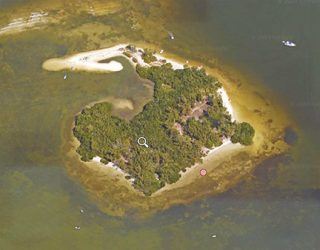By Dave Sully, Lee County Sheriff’s VOICE Volunteer

Recently, a small group spent the night there, but when they awoke and returned to the shore the next morning, they discovered their boat was gone, a sobering thought since the mainland was much too far away to reach by swimming. It would also be much too dangerous to even attempt. Sensing the crisis of the moment, they immediately contacted authorities, namely the Coast Guard and the Sheriff’s Office to report that their boat had been stolen.
On patrol not far away, Lee County Sheriff Marine Unit Deputy Alan Bryant and I responded to the call and headed to the scene. When we heard the circumstances surrounding the “theft,” Deputy Bryant was immediately skeptical, reasoning that it was highly unlikely that thieves would venture to an island in the dark of night to attempt to steal a boat. They would risk being detected by any number of people, and the approach to the island is extremely shallow, making it even more problematical to effect a theft.
While on our way to the scene we rendezvoused with the Coast Guard, who assured us that other boaters were out looking for the missing craft and if needed, the owners of the missing boat would be transported to shore. Just as we approached the beach where the owner of the boat was ready to meet us, the report came that the boat had been found adrift by his friends who were assisting in the search. The culprit here? You guessed it. The tide.
The boat owner assured us he had placed two anchors to secure the boat overnight. We don’t know for sure, but we suspect the most likely scenario was that the anchors never gripped in the soft sand surrounding the island (and which forms most of the sea bottom in the region) and the lines were too short, meaning that when the tide came in and lifted the boat, the anchors were rendered ineffective, allowing the rising tide to carry the boat away from shore where currents and breezes took over, sending the craft on its merry way.
The good news was that his friends were returning it before it fell into the hands of unscrupulous people who may have made off with it, or hitting the Sanibel Causeway bridges, where it was headed, which could have inflicted serious damage.
The lesson to be learned here is that when securing your vessel in similar circumstances, be acutely aware of the effect of the tide when setting anchors. Especially important is to make sure you have enough line deployed to allow the commonly used sand anchors to perform effectively. Deputy Bryant allowed that in the Coast Guard, the rule of thumb was that anchor lines should be seven times the depth of the water. He also suggested that in the future boat owners should also tie off to a solid object on shore, be it one of the mangrove trees that grow on most area islands or some other secure structure., negating any effect that the tide may have on your anchors.
By the way, keep in mind that the opposite of rising tides can be the effect of lowering tides. You can beach your boat bow first and wake up in the morning to find your whole boat high and dry, making your stay on the island a little longer.
Hence, a knowledge of tides is invaluable when mooring your boat.
This particular episode ended happily. Taking a couple extra precautions will prevent you from having the same experience as the Picnic Island campers, with a possibly different ending.
